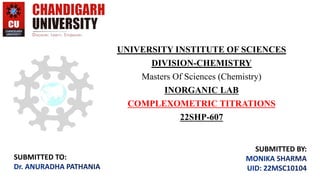
Determine Metal Ions Using Complexometric Titration
- 1. UNIVERSITY INSTITUTE OF SCIENCES DIVISION-CHEMISTRY Masters Of Sciences (Chemistry) INORGANIC LAB COMPLEXOMETRIC TITRATIONS 22SHP-607 SUBMITTED TO: SUBMITTED BY:
- 2. Complexometric titration (sometimes chelatometry) is a form of volumetric analysis in which the formation of a coloured complex is used to indicate the end point of a titration. Complexometric titrations are particularly useful for the determination of a mixture of different metal ions in solution. An indicator capable of producing an unambiguous color change is usually used to detect the end-point of the titration.
- 3. Reactions for Complexometric Titration In theory, any complexation reaction can be used as a volumetric technique provided that: 1. the reaction reaches equilibrium rapidly after each portion of titrant is added. 2. interfering situations do not arise. For instance, the stepwise formation of several different complexes of the metal ion with the titrant, resulting in the presence of more than one complex in solution during the titration process. 3. a complexometric indicator capable of locating equivalence point with fair accuracy is available. In practice, the use of EDTA as a titrant is well established.
- 4. Indicators To carry out metal cation titrations using EDTA, it is almost always necessary to use a complexometric indicator to determine when the end point has been reached. Common indicators are organic dyes such as Fast Sulphon Black, Eriochrome Black T. Color change shows that the indicator has been displaced (usually by EDTA) from the metal cations in solution when the endpoint has been reached. Thus, the free indicator (rather than the metal complex) serves as the endpoint indicator.
- 5. METAL ION INDICATORS The success of an EDTA titration depends upon the precise determination of the end point. The most common procedure utilises metal ion indicators. The requisites of a metal ion indicator for use in the visual detection of end points include : (a) The colour reaction must be before the end point, when nearly all the metal ion is complexed with EDTA, the solution is strongly coloured. (b) The colour reaction should be specific or selective. (c) The metal-indicator complex must possess sufficient stability, otherwise, due to dissociation, a sharp colour change is not attained. The metal-indicator complex must, however, be less stable than the metal-EDTA complex to ensure that, at the end point, EDTA removes metal ions from the metal indicator-complex. The change in equilibrium from the metal indicator complex to the metal-EDTA complex should be sharp and rapid. (d) The colour contrast between the free indicator and the metal-indicator complex should be readily observed. (e) The indicator must be very sensitive to metal ions (i.e. to pM) so that the colour change occurs as near to equivalence point as possible. (f) The above requirements must be fulfilled within the pH range at which the titration is performed.
- 6. Complex titration with EDTA EDTA, ethylenediaminetetraacetic acid, has four carboxyl groups and two amine groups that can act as electron pair donors, or Lewis bases. The ability of EDTA to potentially donate its six lone pairs of electrons for the formation of coordinate covalent bonds to metal cations makes EDTA a hexadentate ligand. However, in practice EDTA is usually only partially ionized, and thus forms fewer than six coordinate covalent bonds with metal cations. Disodium EDTA is commonly used to standardize aqueous solutions of transition metal cations. Disodium EDTA (often written as Na2H2Y) only forms four coordinate covalent bonds to metal cations at pH values ≤ 12. In this pH range, the amine groups remain protonated and thus unable to donate electrons to the formation of coordinate covalent bonds. Note that the shorthand form Na4-xHxY can be used to represent any species of EDTA, with x designating the number of acidic protons bonded to the EDTA molecule.
- 7. EDTA forms an octahedral complex with most 2+ metal cations, M2+, in aqueous solution. The main reason that EDTA is used so extensively in the standardization of metal cation solutions is that the formation constant for most metal cation-EDTA complexes is very high, meaning that the equilibrium for the reaction: M2+ + H4Y → MH2Y + 2H+ lies far to the right. Carrying out the reaction in a basic buffer solution removes H+ as it is formed, which also favors the formation of the EDTA-metal cation complex reaction product. For most purposes it can be considered that the formation of the metal cation. EDTA complex goes to completion, and this is chiefly why EDTA is used in titrations / standardizations of this type.
- 8. THANK YOU